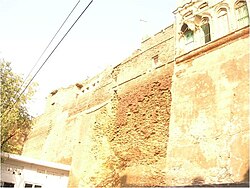| Gujrat Fort | |
|---|---|
 | |
 | |
| General information | |
| Location | Gujrat, Punjab, Pakistan |
| Coordinates | 32°34′29″N 74°04′36″E / 32.574667°N 74.076558°E |
Gujrat Fort, also known as Akbari Fort, is a fort in Gujrat, Pakistan.[1]
History
[edit]During 1587[2] or 1596–97, Mughal Emperor, Akbar, commissioned the construction of a fort in Gujrat, which included five gates.[3][4] This fortified settlement housed all city inhabitants who, for security purposes, were restricted from entry or exit after nightfall.[3]
-
The fort of Gujrat, Punjab, lithograph by Lieutenant W. L. D. Smith, after his own painting, Day & Son, London, 1849
Gates
[edit]The gates bear unique names reflecting their respective histories and orientations.[3] The eastern Shah Daula Gate, or Shahdauli Gate, pays tribute to saint Kabiruddin Shahdoula Daryai.[3][5]
The westward-facing gate, known as Kabuli or Dhakki Gate, derives its name from its direction towards Kabul.[3][4]
In the North stands the Sheeshiyan Wala Gate, famed for its decorative glasswork roof.[3][4] "Shishi," a Scandinavian term signifying graveyard, possibly indicates the gate's proximity to a burial site.[3]
The southern gate, originally termed Kalari Gate, is now known as Shah Faisal Gate, named after three neighboring southern villages: Kalara Dewan Singh, Kalara Rahwala, and Kalara Punawan.[3][4]
Lastly, the Timble Gate, situated adjacent to the Shahdauli gate, completes the quintet of these historical entrances.[3]
References
[edit]- ^ "Important Places | District Gujrat". Archived from the original on 2023-05-20. Retrieved 2023-05-20.
- ^ "4 Historical Gates of Gujrat Fort". gujratpakistan.com. Retrieved November 22, 2023.
- ^ a b c d e f g h i Butt, Waseem Ashraf (June 16, 2016). "Last vestige of Mughal era in Gujrat". DAWN.COM. Archived from the original on May 20, 2023. Retrieved May 20, 2023.
- ^ a b c d Correspondent, The Newspaper's (January 3, 2020). "Gujrat historical sites to be restored". DAWN.COM. Archived from the original on May 20, 2023. Retrieved May 20, 2023.
- ^ "THE CHUAS OF SHAH DAULAH AT GUJRAT, PAKISTAN: Evidence, Historical Background and Development, with Bibliography 1839-2009". Archived from the original on 2023-05-20. Retrieved 2023-05-20.


Well, that’s interesting to know that Psilotum nudum are known as whisk ferns. Psilotum nudum is the commoner species of the two. While the P. flaccidum is a rare species and is found in the tropical islands. Both the species are usually epiphytic in habit and grow upon tree ferns. These species may also be terrestrial and grow in humus or in the crevices of the rocks.
View the detailed Guide of Psilotum nudum: Detailed Study Of Psilotum Nudum (Whisk Fern), Classification, Anatomy, Reproduction